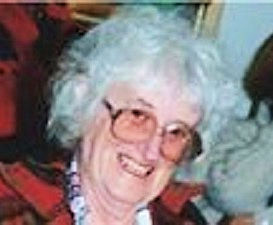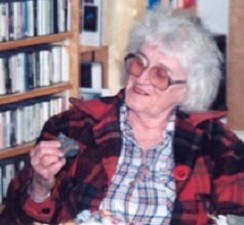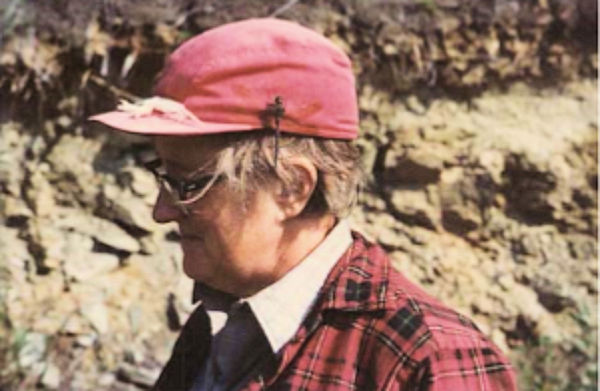 |
Florence R. 'Flo' Weber Fairbanks, AK QCWA # 12694 Chapters 92 and 120 |
 |
OM: Al, KL7AG, Q# 10358 (SK)
Florence Robinson Weber was born in Milwaukee, Wisconsin, on Aug. 26, 1921. Her father was from England and her mother from Germany. Florence was their only child. In 1936, she visited Germany with her High School German Club and attended the 1936 Olympics Games in Berlin, where she saw Hitler. After high school, she attended the University of Chicago. While there, she met Florence Rucker, who was to be her lifelong friend. Both women studied geology and got master's degrees from UC in 1943 and obtained amateur radio licenses, KL7AZ and KL7DDB. Through the mid 50s, their lives were almost identical. Both worked for Shell Oil in Houston and learned to fly in '45. In '47, they learned to drive a car and made a trip up the Alaska Highway the first year it was open to the public. Both decided to live in Alaska. In '49 they got jobs with the US Geological Survey employed in the early oil exploration efforts in NPR-IV. In 1950, they bought a Cessna 140 and flew all over Alaska. USGS sent them back to Washington, D.C., in '54 (ugh!). In '56, they bought a Super Cub on floats and flew from D.C., across Canada to Mackenzie Delta and finally to Fairbanks. Again they worked for USGS. The 1957 National Geographic Magazine had an article about a 700-mile kayak trip from Whitehorse to Eagle taken by the two Florences, two other female friends and one lone man. During summer of '57, they floated the Porcupine River from Old Crow to Ft. Yukon. Also in '57, Florence Rucker married Richard Collins and their lives took separate paths.
Florence Robinson continued her career with the USGS, which lasted over 40 years. She wrote reports examining the routes for the numerous roads proposed across Alaska. She was co-author on the first geologic map of the Fairbanks Quadrangle in '66, and the engineering geology maps for the trans-Alaska pipeline route in '71. Florence either authored or coauthored over 100 publications on Alaskan geology and often shocked her colleagues with new interpretations of the area. She was proven right most times. Her main area of expertise was the Tanana-Yukon uplands. Florence joined the Geological Society of America in 1950 and was elected to Fellowship in the Society in 1967. In '87, UAF awarded her an honorary doctorate for her Alaska work. A member of the awards committee said they received more testimonials nominating Florence than they ever received for anyone. And in the mid-1990s, she was awarded the U.S. Department of the Interior Meritorious Service Award. She was one of Alaska's most dedicated and respected geologists. In '97, at age 76, just months after a hip replacement, she was hiking the hills south of Rampart and doing what she loved.
Florence also had an active nonprofessional life. In August 1959, she married a man she met on the air - Albert Weber - KL7AG. For the first couple years they lived in an old Quonset, and in the '60s they built a home on Grenac Road - with a ham antenna farm and emergency generator. Everything was ready for the '67 flood. Their ham shack was communications center for that emergency - and their floor was littered with sleeping hams. In '68, they were probably the first (with their friends the Klopfs) to canoe from Nome Creek to Beaver Creek to the Yukon River to Tanana. Through the years, as long as they were physically able, the Webers were active canoers, kayakers, square dancers, divers, bicyclists, gardeners, skiers, photographers, world travelers and always willing to try something new.
Florence's last nine years were spent in the Pioneers' Home. She died on Jan 18, 2018, at age 96. A celebration of her life will be at 1 p.m. Sunday, Jan. 27, at the Palace Theatre/ Saloon in Pioneer Park.
Published in Daily News-Miner on Jan. 20, 2019
From Alaska Geology:
Alaska Geological Society 2009 Honorary Membership And Distinguished Service Award to:
Florence Marie Robinson Weber
The AGS is pleased to honor Florence Weber as one of our own and as someone who has contributed so much to Alaska geology.
Thank you, Florence!
Florence Weber Extraordinary geologist, scientist, and adventurer
By Ric Wilson, USGS colleague and friend
Originally from Milwaukee, Wisconsin, Florence attended the University of Chicago studying for a degree in geology. There, in her sophomore year, she met Florence Rucker (Collins) and began a lifelong friendship when they were paired in a geology field course by a professor who wanted to get the two Florences together. While undergraduates at Chicago, the Florences had been regaled with stories of Alaska by fellow student Joe Hoare, who had worked with the USGS during 1942 and later. After graduating in June 1943, they both took temporary jobs at Shell Oil in Houston, replacing the men who had left to fight in World War II. While there inspired by an exhibit of US warplanes intended to raise patriotic feelings but which instead piqued their interest in learning to fly they obtained pilot licenses. After the war, they returned to the University for more study. Both women completed their Master s degrees in geology in 1948. While in graduate school, they took a summer road trip to Alaska over the newly opened Alaska Highway. They decided they liked it, and were able to secure positions in 1949 with the Naval Oil Unit of the US Geological Survey. They worked in Alaska until 1954, when the Survey moved the office to Washington, D.C. They followed to D.C. and spent two years writing reports, which became the 12 chapters of USGS Professional Paper 305, which discusses the subsurface and engineering geology aspects of the USGS exploration of NPRA between 1944 and 1953. In order to get back into the field, they made use of their pilot licenses and offered the Survey a special service: access by seaplane into the interior of Alaska. Moving together to Alaska, the two Florences flew up from Washington, D.C., in a SuperCub on floats; that plane continues to be flown by Florence Collins daughters out of Lake Minchumina. They wouldn t hire women as fieldworkers otherwise, Florence Collins said. The float plane could go places the guys couldn t go. (In part, paraphrased from the Spring 2004 Charitable Giving brochure of the University of Chicago.)
During Florence Weber s long career with the USGS, she was involved in many important studies in Alaska, authoring or co-authoring more than 100 maps, articles, and abstracts. Following the work on NPRA, starting in the late 1950s, Florence worked on and produced a number of studies examining routes for proposed roads across Alaska. She published a study for a road to McGrath and produced an internal report for a road to Nome; today her work on the road to Nome should prove of interest to the State. Beginning a long association with Troy Pé, she and Troy collaborated on a number of engineering geologic studies around the state. Concurrently, Florence began building expertise on the regional bedrock geology of Interior Alaska and with Troy and Clyde Wahrhaftig published a geologic map of the Fairbanks quadrangle in 1966. Florence continued her engineering geologic work and produced engineering geologic maps for the Trans Alaska Pipeline System route through Interior Alaska in 1971. In collaboration with Bob Chapman and Bond Taber, Florence coauthored a preliminary geologic map of the Livengood quadrangle, also published in 1971. In 1976, a series of detailed geologic maps of the Fairbanks area were published in collaboration with Troy Pé. In 1986, she went back to the Livengood area as a project leader for the Alaska Mineral Resource Assessment Program (AMRAP) and produced a much improved and more detailed Livengood quadrangle geologic map. Also coming out of that work, a Middle Devonian gastropod from the Cascadian Ridge unit of the Livengood quadrangle was named after her, Mastigospira weberae.
Always willing apply her skills to something different, in the mid-1980s, Florence joined the Port Moller, Alaska Peninsula AMRAP project to guide the mapping of surficial deposits. Her insight led to recognition that glaciers originating offshore had a significant role on the Alaska Peninsula. This in turn had a major impact on the interpretation of the stream-sediment geochemistry and ultimately the final resource assessment. Because the glaciers flowed from offshore and across highly mineralized Unga Island, the moraines they left on the Alaska Peninsula were gold-bearing and contributed gold to the stream-sediments draining those moraines. Once streamsediment sampling was done upstream of the moraines, it was recognized that Florence was correct and that the apparent mineralization on the mainland associated with that area was not present. Her work on the Alaska Peninsula continued and with her assistance, a revised Cold Bay and False Pass quadrangle geologic map was produced that incorporated mapping of glacial deposits, along with a paper describing the major new interpretation of the regional glacial record.
Florence s regional stratigraphic insights allowed her to make a very strong case for significantly greater motion along the Tintina Fault System than was previously recognized, in part due to recognition of the system having 3 distinct strands. Similarly, she suggested that some of the same overthrusting processes seen along the Tintina Fault System may have taken place along the Denali Fault System.
Over the years, a number of well-earned honors have come her way. Florence joined the Geological Society of America in 1950 and was elected to Fellowship in the Society in 1967. With the support and urging of her many friends and colleagues, the University of Alaska Fairbanks awarded Florence an Honorary Doctor of Science in May 1987. And in the mid-1990s, she was awarded the U.S. Department of the Interior Meritorious Service Award for her long and productive career in service to the Nation. Florence has over 100 publications on Alaska geology as senior author or co-author.
One of Florence s skills was as a ham radio operator (now KL7AZ) and in the 1950s she developed a radiopal communication with Al Weber (now KL7AG), who lived in Anchorage. This communication blossomed into romance and in 1959 they were married and Al moved to Fairbanks. Outside of the office, Florence and Al were always involved in some adventure, whether it was bicycling around the state, canoeing and kayaking on many rivers, learning to play various musical instruments, or learning to scuba dive. Trips included New Zealand, Australia, and many a motor home tour of the US and Canada. The number of motorhomes they have worn out is impressive. In 1957, Florence was one of the women featured in a National Geographic article about 6 women and 1 man who traveled down the Yukon River from Whitehorse to Eagle by Folboat. Because there were two Florences on the trip, they were nicknamed Ru and Ro, for Florence Rucker and Florence Robinson, respectively. According to the National Geographic article, Florence Robinson (Weber) was called a watchbird, because she never dozed off on the days they drifted down the river; she was always watching for hazards and interesting things to see. After completing the Whitehorse to Eagle trip, the two Florences continued 150 miles downstream to Circle. The article was named after a popular (but politically incorrect) song of the day, Squaws Along the Yukon.
One of the compliments paid to Florence recently was that unlike many of the geologists of her day who were quite territorial, when she found something interesting, she was quick to bring in appropriate experts to and share the discovery, even to the extent of turning it over to those she brought in.
Volume 39 Number 9 May 2009 Page 5
